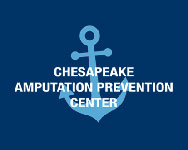
You notice a sore on your foot. It’s open, maybe red and swollen, but it doesn’t hurt. You figure if it were serious, it would be painful. So you cover it with a bandage and move on with your day.
At Annapolis Foot & Ankle Center, we hear this story all the time, and it often ends with a patient returning weeks later, now dealing with an infected wound, dead tissue, or even the threat of amputation. The truth is, pain isn’t always a reliable signal of severity, especially when it comes to the feet. In some cases, the absence of pain is actually a red flag. Here’s why.
How Can a Serious Wound Not Hurt?
When we think about injuries, we think about pain; it's how our bodies warn us something is wrong. But when the nerves in your feet aren’t working properly, that warning system breaks down.
This is especially true for people with diabetes, vascular disease, or neuropathy. In these cases, the nerves that normally detect pressure, temperature, and injury are damaged or dulled, leaving you without the important warning sign of pain with your injury.
Common reasons a wound might not hurt include:
- Peripheral neuropathy. Nerve damage, often caused by diabetes, numbs sensation in the feet. You may not feel cuts, blisters, or burns at all.
- Poor circulation. Without strong blood flow, your body can't mount a strong pain response or heal properly.
- Spinal issues. Nerve compression or damage in the spine can disrupt sensation in the lower limbs.
Someone with neuropathy may step on a tack, develop a blister from tight shoes, or suffer a scrape from a rough surface—and never realize they’re injured.
The Risks of Ignoring a Foot Wound
Because the feet are constantly under pressure, even a small injury can escalate quickly. When a wound is ignored, it’s not just slower to heal—it’s more likely to get worse.
Here’s what can happen when a “painless” wound is left untreated:
- Infection. Dirt and bacteria can easily enter broken skin. Without treatment, this can lead to cellulitis, abscesses, or even bone infections (osteomyelitis).
- Ulceration. Pressure and friction deepen the wound, breaking down skin and tissue.
- Necrosis. If tissue doesn’t get enough blood flow, it can begin to die.
- Amputation. In advanced cases, particularly among diabetic patients, the only way to stop the spread of infection is to remove the affected area.
Our Chesapeake Amputation Prevention Center at Annapolis Foot & Ankle Center offers advanced wound care therapies to help patients avoid these outcomes. But the sooner we intervene, the better your chances of recovery.
Why Diabetics and At-Risk Patients Need to Be Especially Cautious
Certain health conditions make you more vulnerable to foot wounds—and less likely to notice them.
High-risk groups include:
- Diabetics. High blood sugar damages nerves and blood vessels, impairing both sensation and the healing process. Diabetic foot ulcers are a leading cause of hospitalization among diabetics.
- People with peripheral artery disease (PAD). PAD restricts blood flow to the legs and feet, slowing healing and increasing the chance of infection.
- Patients with chronic kidney disease. Kidney function affects circulation, immunity, and overall healing ability.
- Older adults. Aging can reduce skin integrity, circulation, and immune function.
- Chemotherapy patients. Certain cancer treatments damage peripheral nerves and compromise immune defense.
If you fall into any of these categories, foot wounds should never be ignored, even if they seem minor or painless.
What to Watch For: Signs a Foot Wound Needs Medical Attention
Even if your wound doesn’t hurt, other signs may indicate it’s more serious than you think.
Seek care if your wound:
- Looks red, swollen, or shiny
- Has drainage (especially if it’s yellow, green, or foul-smelling)
- Shows signs of tissue breakdown or black areas
- Doesn’t begin to heal after 3–5 days
- Occurred without you noticing how it happened
- Is located on a pressure point, like the ball of the foot or heel
Also, if you notice redness spreading beyond the wound or develop a fever, this may indicate a spreading infection that requires urgent medical attention.
What to Expect From a Podiatrist Evaluation
At Annapolis Foot & Ankle Center, our podiatrists don’t just treat the wound; we evaluate the underlying cause and create a long-term plan to prevent recurrence.
Your visit may include:
- Wound assessment. We measure the size, depth, and condition of the wound to determine severity.
- Circulation check. We evaluate blood flow using tools like Doppler ultrasound or ABI (ankle-brachial index) testing.
- Sensation testing. If you’re not feeling pain, we’ll determine whether neuropathy is present.
- Infection screening. We may take a culture to identify harmful bacteria or test for bone involvement.
- Imaging. We may use X-rays or MRIs to rule out deeper damage.
From there, we’ll tailor a treatment plan that addresses both healing and prevention.
How We Treat Foot Wounds That Don’t Hurt
Treating a foot wound involves more than just cleaning and bandaging. Our comprehensive approach supports healing from the inside out.
Wound care may involve:
- Debridement. Carefully removing dead or infected tissue to promote healing.
- Offloading. Relieving pressure with special shoes, casts, or inserts so the wound isn’t reopened by daily activity.
- Topical treatments. Medicated dressings, antimicrobial gels, or growth-factor ointments.
- Advanced therapies. Biologic grafts, skin substitutes, and negative pressure wound therapy (vacuum-assisted healing).
- Vascular referral. If blood flow is poor, we may coordinate with vascular specialists to restore circulation.
We also collaborate with your primary care provider, endocrinologist, or other specialists to ensure that your blood sugar, medications, and other health factors are optimized for optimal healing.
The Role of Preventive Care in Foot Health
If you’re prone to foot wounds or have reduced sensation, the best approach is prevention. We help patients protect their feet through education and regular monitoring.
Prevention strategies include:
- Daily foot checks. Look for cuts, blisters, redness, or swelling—especially in areas you can’t feel well.
- Proper footwear. Wear shoes that fit well, protect your feet, and reduce friction. Avoid walking barefoot.
- Routine podiatric visits. Regular evaluations catch problems early and reduce complications.
- Glycemic control. Managing blood sugar is one of the most effective ways to prevent foot problems for diabetics.
- Moisture management. Keep feet clean and dry, especially between the toes, to prevent fungal infections and skin breakdown.
Looking at the Whole Patient, Not Just the Wound
At Annapolis Foot & Ankle Center, we take a holistic approach to wound care. That means we don’t just focus on healing a single sore—we look at how your overall health, mobility, circulation, and lifestyle all play a role in your recovery.
We understand that a wound can affect far more than just your foot. It may keep you from working, exercising, caring for your family, or simply enjoying your life. Our goal is to get you safely back on your feet—not just quickly, but fully.
A Wound Without Pain Is a Wound That Still Needs Attention
When it comes to foot wounds, the absence of pain isn’t reassurance—it’s a reason to be more cautious. Without the natural alarm system of discomfort, it’s easy to underestimate the seriousness of an injury until it’s too late.
If you have diabetes, poor circulation, or reduced sensation, every wound deserves attention—no matter how small or painless it seems. With expert podiatric care, early treatment, and ongoing prevention, you can avoid complications and protect your mobility for years to come.
At Annapolis Foot & Ankle Center, we're committed to treating not just the wound, but the person attached to it with skill, compassion, and a plan for long-term health.






